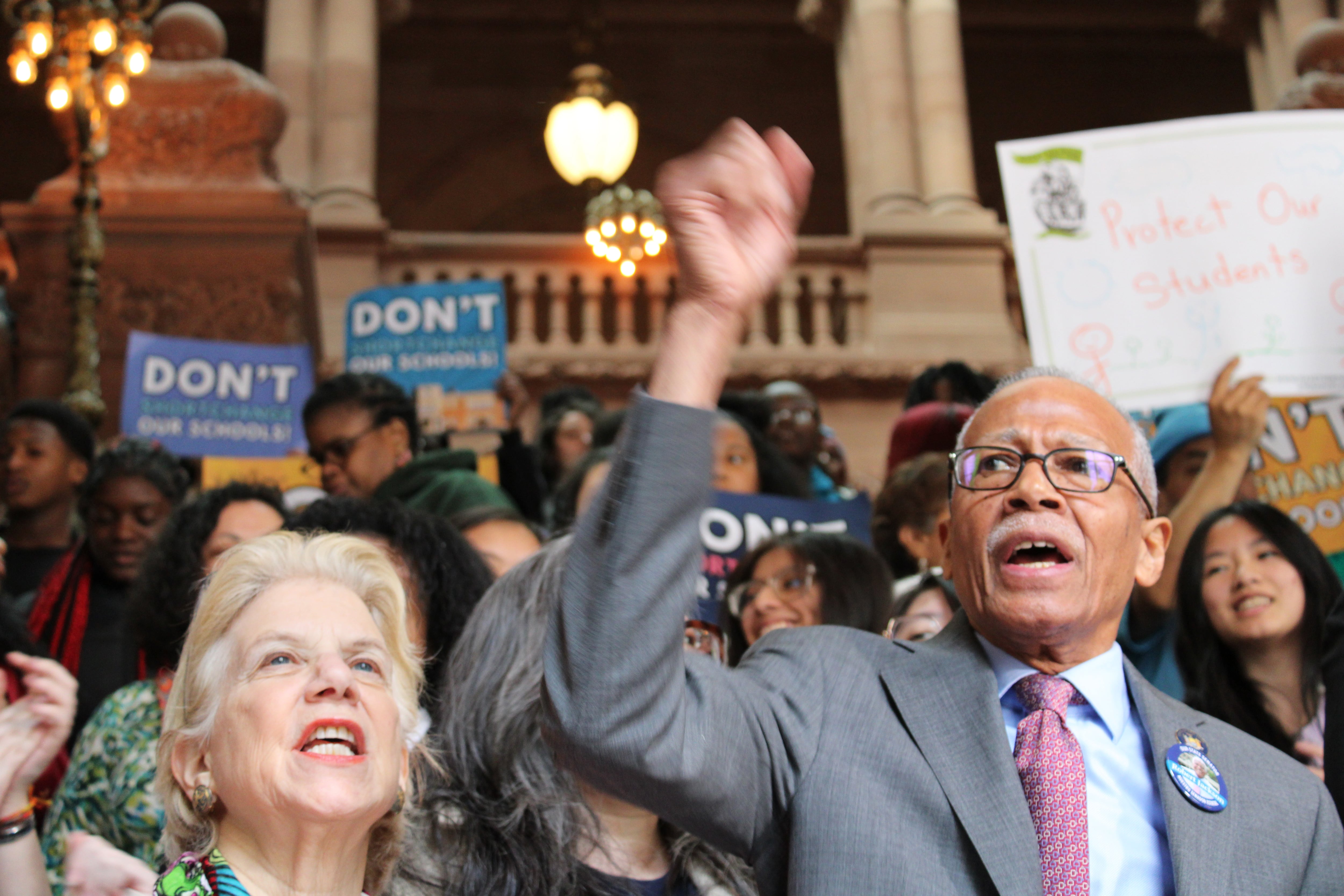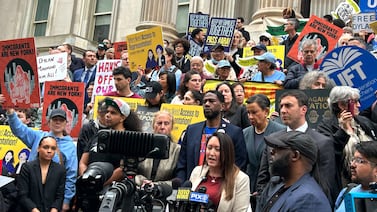Sign up for Chalkbeat New York’s free daily newsletter to get essential news about NYC’s public schools delivered to your inbox.
Ahead of an April 1 budget deadline, state lawmakers are pushing back on a proposal from Gov. Kathy Hochul that would result in New York City’s school system receiving $350 million less than expected.
Hochul proposed tweaking the state’s nearly two-decade-old school funding formula, known as Foundation Aid, to update how student poverty is measured. There has been widespread agreement that the formula needs to change, but some want to see a more significant revamp than the governor’s plan — with additional adjustments that would help high-need districts like New York City.
And many advocates want to see the state step up at a time when the Trump administration has been gutting the U.S. Department of Education’s staff and taking steps to dismantle the agency.
“It’s important that we recognize that a budget is a moral document, and what you put in a budget shows us what you are concerned about,” NeQuan McLean, a parent leader from Bedford-Stuyvesant Brooklyn and president of the Education Council Consortium, said at a rally in Albany this week.
Foundation Aid takes student need into account, providing additional funding to districts that serve higher populations of students in poverty, among other factors. Needs are typically high across the five boroughs, where more than 70% of students live in poverty. New York City schools are seeing additional strains, many advocates say, after welcoming an estimated 48,000 migrant students since summer 2022, many of whom need dedicated English language instruction as well as other social support. More than 16% of students citywide are learning English as a new language.
State Sen. John Liu, a Queens Democrat who chairs the Senate’s New York City education committee, pledged to keep the pressure on Hochul. “In these last rounds of budget negotiations, we’re going to fight to make sure New York City is not shortchanged,” he said.
A spokesperson from Hochul’s office said the governor has delivered more funding to public schools than any previous New York governor and noted that her proposed total education plan of $14 billion for fiscal year 2026 represents a $703 million increase from the previous year.
How much money does NYC get through Foundation Aid?
When it comes to school funding, New York City gets seven times more money from the state than the federal government.
Of this year’s roughly $40 billion New York City Education Department budget, about 37% — or $15 billion — came from the state. More than $9.5 billion of that money came through the state’s Foundation Aid formula.
When was the Foundation Aid formula created?
The formula traces its origins back to a landmark court case the Campaign for Fiscal Equity filed more than 30 years ago against the state, alleging that its school funding system violated the constitutional rights of New York City students to a “sound basic education.”
After a prolonged legal battle, the state’s highest court agreed, paving the way for Foundation Aid. But the fight didn’t end there. After the formula was implemented in 2007, it took more than a decade before it was fully funded.
By the time Hochul and the state legislature agreed to fully fund Foundation Aid in 2023, however, the formula was outdated.
What is Hochul proposing for Foundation Aid?
Hochul’s proposed tweaks would update the poverty weight, replacing the 2000 Census poverty rate with the most recent Census Small Area Income and Poverty Estimates. But advocates complain that this data relies on inadequate federal poverty guidelines with no adjustments for local cost of living, which in turn would result in New York City getting $350 million less than it would under the current formula.
The current federal poverty threshold for a family of four is roughly $32,150 a year. Making ends meet on that amount of money in New York City likely looks very different than in other parts of the state, advocates point out.
(Hochul also proposed the formula stop using federal free- and reduced-price lunch eligibility as a basis for measuring student need, instead switching to broader “economically disadvantaged” student counts — a change could benefit the city.)
What did the Senate and the Assembly propose for the formula?
In their one-house budgets, both the Senate and Assembly proposed updating the formula’s Regional Cost Index, which aims to address variations for cost of living expenses in different parts of the state. This hasn’t been updated since 2006, and New York City’s living expenses have greatly increased over the past 20 years.
The New York Board of Regents as well as a report from the Rockefeller Institute called for updating this metric. The governor, however, did not include an update to the Regional Cost Index, though she proposed updating the outmoded poverty data.
The proposed updates from the Senate and Assembly would help offset the shortfall from the governor’s changes. The Senate proposed restoring about $288 million, while the Assembly’s proposal called for including about $200 million, according to a report released Friday by the Alliance for Quality Education, which has long fought to fully fund the Foundation Aid formula.
The Assembly also proposed increasing the formula’s weight for students learning English as a new language, which would direct about $152 million to New York City. Schools have seen a significant increase in the number of English language learners enrolled over the past few years, and many schools are still struggling to meet their instructional needs.
What else are advocates calling for?
In addition to updating the Regional Cost Index, a coalition of more than 100 organizations want the formula to include additional weights for students in temporary housing, those in foster care, and students with disabilities.
They want more funding for students in the city’s free preschool programs for 3- and 4-year-olds. And they want more resources to help New York City implement the state’s mandate to limit class sizes.
Many advocates are urging the state to ensure schools are adequately funded as possible federal funding cuts could hurt programs that provide school meals and support students from low-income households and students with disabilities.
“The consequences will be severe: more children going hungry, more families without the support they need, and even wider educational disparities,” the Alliance for Quality Education report said, “especially for Black, brown, immigrant, and lower-income students.”
Amy Zimmer is the bureau chief for Chalkbeat New York. Contact Amy at azimmer@chalkbeat.org.






